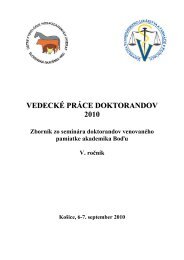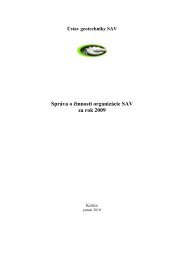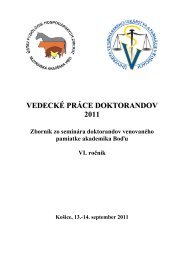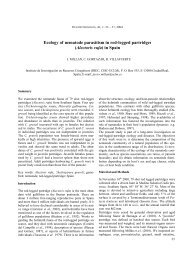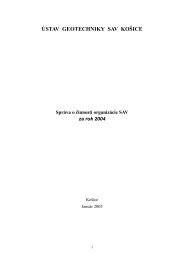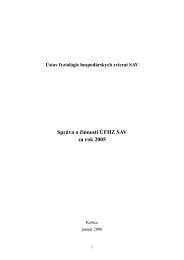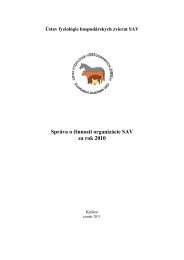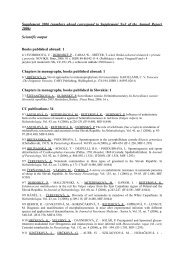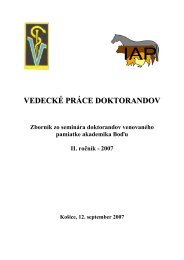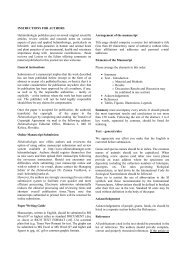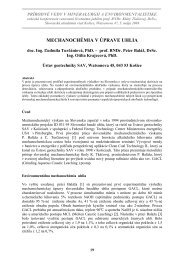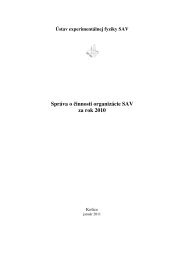Troglotrema acutum (Digenea) from carnivores in the Czech Republic
Troglotrema acutum (Digenea) from carnivores in the Czech Republic
Troglotrema acutum (Digenea) from carnivores in the Czech Republic
Create successful ePaper yourself
Turn your PDF publications into a flip-book with our unique Google optimized e-Paper software.
6 squares (15.4 %) only. If we complement <strong>the</strong> positive<br />
f<strong>in</strong>d<strong>in</strong>gs of T. <strong>acutum</strong> <strong>from</strong> our material with previously<br />
published data, <strong>the</strong>n this trematode has been reported <strong>from</strong><br />
51 squares so far, which represents 8.1 % of <strong>the</strong> area of <strong>the</strong><br />
CzR. Comparison of <strong>the</strong> localities with T. <strong>acutum</strong> with <strong>the</strong><br />
mapp<strong>in</strong>g grid <strong>in</strong>dicates <strong>the</strong> presence of preferred smaller or<br />
larger regions bound to river or pond ecosystems <strong>in</strong> sou<strong>the</strong>rn<br />
Bohemia, �eskomoravská vrchov<strong>in</strong>a Highlands<br />
and especially <strong>in</strong> nor<strong>the</strong>rn and sou<strong>the</strong>rn Moravia.<br />
Fig. 4. Geographical distribution of T. <strong>acutum</strong> <strong>in</strong> <strong>the</strong> <strong>Czech</strong><br />
<strong>Republic</strong> (l – our f<strong>in</strong>d<strong>in</strong>gs;¡ – o<strong>the</strong>r published data)<br />
4. Vertical distribution of T. <strong>acutum</strong> <strong>in</strong> <strong>the</strong> <strong>Czech</strong> <strong>Republic</strong><br />
Vertical distribution of T. <strong>acutum</strong> was recorded for all<br />
f<strong>in</strong>d<strong>in</strong>gs of <strong>in</strong>fected hosts. Positive f<strong>in</strong>d<strong>in</strong>gs appeared <strong>in</strong><br />
hosts <strong>from</strong> localities with altitudes <strong>from</strong> 167 to 745 m a.s.l.<br />
The majority of <strong>the</strong> f<strong>in</strong>d<strong>in</strong>gs (91.1 %) lay under 450 m<br />
a.s.l., and 55.3 % of <strong>the</strong> f<strong>in</strong>d<strong>in</strong>gs were <strong>from</strong> <strong>the</strong> range 201-<br />
300 m a.s.l. (Fig. 5).<br />
Fig. 5. Vertical distribution of T. <strong>acutum</strong> f<strong>in</strong>d<strong>in</strong>gs <strong>in</strong> <strong>the</strong> <strong>Czech</strong><br />
<strong>Republic</strong><br />
5. Focal character of T. <strong>acutum</strong> <strong>in</strong>fections<br />
Geographical aspects of T. <strong>acutum</strong> distribution <strong>in</strong>dicate <strong>the</strong><br />
existence of foci of this parasite. We consider <strong>the</strong> repeated<br />
dfôkjsgôdfjgôsdjfgô<br />
28<br />
f<strong>in</strong>d<strong>in</strong>gs of this parasite at <strong>the</strong> same locality (same map<br />
square) and with<strong>in</strong> <strong>the</strong> period of two and more years to be<br />
<strong>the</strong> evidence of <strong>the</strong> existence of <strong>the</strong>se focuses. Repeated<br />
f<strong>in</strong>d<strong>in</strong>gs of T. <strong>acutum</strong> <strong>in</strong> M. putorius appeared <strong>in</strong> 14 squares<br />
<strong>in</strong> <strong>the</strong> period <strong>from</strong> 1957 to 2001 (Table 3). M. putorius<br />
was <strong>the</strong> s<strong>in</strong>gle host at 64.3 % of <strong>the</strong> <strong>in</strong>fected area (9 squares).<br />
Common <strong>in</strong>fection with M. martes was found at 21.4<br />
% of <strong>the</strong> area (3 squares) and with V. vulpes at 14.3 % of<br />
<strong>the</strong> area (2 squares). The significance of M. putorius as <strong>the</strong><br />
ma<strong>in</strong> host for persistence of <strong>the</strong> focuses of T. <strong>acutum</strong> <strong>in</strong>fection<br />
is also confirmed by <strong>the</strong> fact that <strong>in</strong> o<strong>the</strong>r <strong>carnivores</strong><br />
<strong>the</strong> <strong>in</strong>fection with this trematode was found at 7<br />
squares only, but always <strong>in</strong> a s<strong>in</strong>gle host species and <strong>in</strong> a<br />
s<strong>in</strong>gle year (<strong>in</strong> V. vulpes - 3 localities, M. martes, L. lutra<br />
and M. meles - 1 locality). Only <strong>in</strong> one case at one locality<br />
was <strong>the</strong> <strong>in</strong>fection detected <strong>in</strong> two host species (M. martes,<br />
M. fo<strong>in</strong>a).<br />
Table 3. Localities of repeated occurrence of T. <strong>acutum</strong> <strong>in</strong> <strong>the</strong> <strong>Czech</strong><br />
<strong>Republic</strong><br />
Quadrat Locality Repeated Time Host (s)*<br />
Nos. f<strong>in</strong>d<strong>in</strong>gs range<br />
6167 Záb�eh n. Morav� 7 57 – 59 M.p., M.ma.<br />
6962 Rouchovany 3 89 – 01 M.p.<br />
6965 �idlochovice 5 62 – 87 M.p., M.ma.<br />
7065 Poho�elice 2 69 – 84 M.p., V.v.<br />
6865 Bosonohy 4 62 – 73 M.p. M.me.<br />
6072 Hlavnice 10 67 – 71 M.p., M.ma.<br />
6073 Opava 3 64 – 66 M.p., V.v.<br />
6275 Polanka 2 61 – 71 M.p.<br />
6172 �táblovice 5 62 – 74 M.p.<br />
6174 Háj 4 67 – 70 M.p.<br />
6074 Krava�e 13 58 – 91 M.p.<br />
*) M.p. – Mustela putorius; M.ma. – Martes martes; M. me. – Meles<br />
meles; V.v. – Vulpes vulpes<br />
Discussion<br />
T. <strong>acutum</strong> was orig<strong>in</strong>ally described by Leuckart (1842) as<br />
Distoma <strong>acutum</strong>. Host of <strong>the</strong> type material was M. putorius<br />
<strong>from</strong> Germany. This trematode was later classed <strong>in</strong>to a<br />
newly created genus, <strong>Troglotrema</strong>, by Odhner (1914), who<br />
revised <strong>the</strong> collection of trematodes obta<strong>in</strong>ed by Moniez<br />
(1890) <strong>from</strong> polecats <strong>in</strong> France. Odhner’s description toge<strong>the</strong>r<br />
with <strong>the</strong> description and illustration of an adult trematode<br />
by Baer (1931) present <strong>the</strong> most detailed data<br />
about morphometry of this species so far. The trematodes<br />
obta<strong>in</strong>ed <strong>from</strong> our material fully correspond to <strong>the</strong> descriptions<br />
of T. <strong>acutum</strong> published up to <strong>the</strong> present.<br />
Unfortunately, most of <strong>the</strong> papers about <strong>the</strong> occurrence and<br />
distribution of T. <strong>acutum</strong> <strong>in</strong> <strong>the</strong> <strong>Czech</strong> <strong>Republic</strong> as well as<br />
<strong>in</strong> o<strong>the</strong>r regions published so far are based on <strong>the</strong> presence<br />
of changes <strong>in</strong> <strong>the</strong> visceral part of <strong>the</strong> skull (Stan�k, 1961;<br />
Schmidt, 1993; Hanák and Bene�, 2001). Although some<br />
authors express <strong>the</strong>ir doubts (Olt, 1929; Kotlán, 1960),<br />
such changes may also be caused by nematodes of <strong>the</strong> gedfôkjsgôdfjgôsdjfgô



